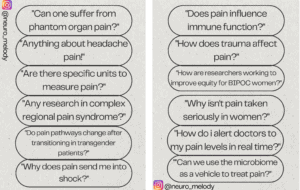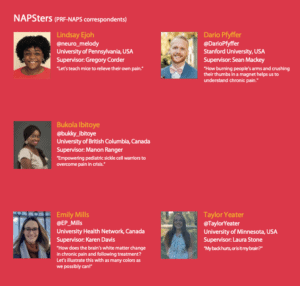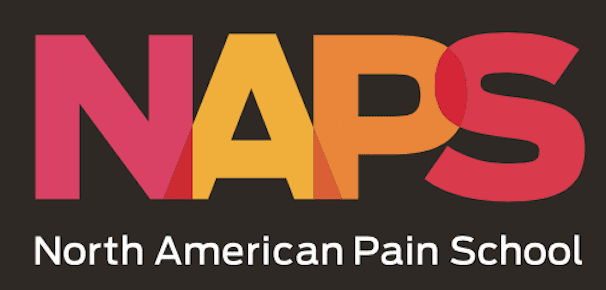Five early-career pain researchers are participating in the PRF-NAPS Correspondents program during the 2023 North American Pain School, taking place from 18-23 June in Montebello, Québec City, Canada. The Correspondents program is a unique science communication training program that provides participants with knowledge and skills needed to communicate science effectively to a wide range of pain researchers, patients, and the greater public. The Correspondents will conduct interviews with NAPS Visiting Faculty and Patient Partners, write summaries of scientific lectures – and provide live blogging too! Take a look at their blog posts from Day 1.
NAPS Blog Posts – Day 1
Do Y’all Have Any Specific Questions?
It’s (Not) All About the Presentation
The Old Taylor Can’t Come to the Phone Right Now….
Do Y’all Have Any Specific Questions?
I am a science communicator and use my voice on social media to guide people toward new discoveries and outlooks in pain research. One of my goals is to inspire my audience – a community of people living with pain, and their friends/family – to explore their curiosities and think critically about pain science.
I started my day excited to discuss questions at the forefront of pain research and share insights from my peers and the Visiting Faculty at NAPS. Aside from simply sharing presentation highlights, I wanted to engage my audience and ask, “Do y’all have any specific questions about pain that I could ask the experts this week?” Here are some of their questions:

These inquiries focus on specific pain disorders, how scientists measure pain, how patients can advocate for themselves, whether researchers are working toward equity for BIPOC (black, indigenous, and other people of color), women in pain, and even how gender-affirming care affects pain (given its sexual dimorphism). All of these questions have left me wondering, “Are we – as pain researchers – asking the questions that people want answered?”
Lindsay Ejoh is a PhD candidate at the University of Pennsylvania, USA. You can follow her on Twitter – @neuro_melody.
From mice to humans, astrocytes to Schwann cells, atopic dermatitis to sickle cell disease, and patient engagement to mentorship – the first full day of NAPS was filled with the brilliant work from fellow NAPSters and pain experts.
Alongside the scientific intellect offered throughout our slate of presentations, my day was enriched with sizzling lunch table conversations with our Patient Partners, Keith Meldrum and Jennifer Daly-Cyr, a brief but highly productive conversation with the amazing Anna Hood, and a stimulating discussion on the challenges of online-based surveys with NAPSters Nicole Mackenzie and Alexandra Neville (who also received a crash course on my journey from Nigeria to Canada).
Need I say it’s been a long day? Rachael Bosma was right when she said, “No naps at NAPS!” But who can nap in a gold mine?
I’m certainly not a gold miner, but I know they’re focused on discovering gold.
Gold isn’t easy to find, but rocks are in abundance. Gold is the things I never knew, but learned today. Rocks are things I knew, but never fully appreciated.
I found tons of gold, but let’s focus on one rock – “I believe you.”
Keith Meldrum emphasized validating a person’s pain, as it can shift them from a place of anger and struggle to a place of acceptance and support. This may seem straightforward, but people’s experiences of pain are often dismissed because some healthcare professionals don’t believe them.
In 1968, American nurse Margo McCaffrey defined pain as whatever the patient says it is, whenever the patient says it is. I believe this still holds true today. Drugs and other interventions are important, but maybe “I believe you” can change someone’s life.
Bukola Ibitoye is a PhD candidate at the University of British Columbia, Canada. You can follow her on Twitter – @bukky_ibitoye.
As a neuroimager, I’m often faced with questions about the role of neuroimaging in pain research and clinical practice. For many outside of this discipline, its limitations often outweigh its benefits. Today I had the opportunity to discuss the powers and perils of neuroimaging with my fellow NAPSters and Visiting Faculty.
A prominent theme during our first full day at NAPS has been the failure of analgesic targets to successfully translate to the clinic. Can we utilize neuroimaging to improve and develop new treatments by better understanding the mechanisms of human pain, instead of what’s studied in our lab models?
Neuroimaging is powerful. Structural imaging has identified basic pain circuits in humans. Positron emissions tomography (PET) has revealed neuroinflammation in the chronic pain brain. Functional neuroimaging has taught us that pain processing involves dynamic interplay between different signal frequencies across networks in the brain.
While functional neuroimaging can provide clinical relief by targeting some of these networks with novel neuromodulatory approaches (like transcranial alternating current stimulation – tACS), the neuroimaging field offers the potential for developing clinical biomarkers.
Such biomarkers could help to assess someone’s susceptibility to pain, lead to a diagnosis, and help to predict treatment outcomes. If validated, brain-based biomarkers offer enormous potential.
Despite these benefits, there are perils when interpreting pain neuroimaging studies.
Will we ever truly understand mechanisms at such large spatial resolutions? A single imaging “voxel” (i.e., a three-dimensional pixel) contains millions of cells – including different types of neurons, glia, and inhibitory/excitatory synapses. With current techniques, it is impossible to tease apart the contribution of these processes to the recorded signal.
Furthermore, exactly what neurological processes are we measuring with functional neuroimaging? On top of stable, trait-like processes, functional neuroimaging also reflects the ongoing moment-to-moment “state” processes. To what degree are these processes reflected in the measured signal, and therefore how reliable are these measures?
Neuroimaging plays an important role in understanding pain mechanisms, and has the potential to become a powerful clinical tool. However, it is our responsibility to acknowledge its limitations with the broader pain research and clinical community.
Emily Mills is a postdoctoral researcher at the Krembil Brain Institute, University Health Network, Toronto, Canada. You can follow her on Twitter – @EP_Mills.
It’s (Not) All About the Presentation
Today was the first full day of the 2023 North American Pain School, and the day I had the opportunity to present my own work to the audience – a room filled with pain experts and some of the world’s renowned pain researchers and clinicians.
Was I excited? Yes.
Was I apprehensive? Yes.
Was I nervous? You bet!
Did I get enough sleep the night before? Yes… but only because I flew to Montreal overnight.
Have I been able to think of anything aside from my presentation since I arrived? Believe it or not, YES! The program at NAPS easily distracted me from my imminent presentation.
How could I not focus on the Executive Committee presentations on their groundbreaking research, or the amazing work of my peers, or Marco Loggia’s talk on imaging chronic inflammation?
I even got the chance to talk to Marco at our topic lunch focused on neuroimaging (definitely one of the best lunch breaks ever!).
What more would I want to experience on such an unforgettable day? Oh… I forgot to tell you about my presentation….
Dario Pfyffer is a postdoctoral research scholar at Stanford University, California, USA. You can follow him on Twitter – @DarioPfyffer.
The Old Taylor Can’t Come to the Phone Right Now….
I wouldn’t necessarily label myself a “Swiftie,” but here I am quoting Taylor Swift songs.
Yes, Taylor Swift will be in Minneapolis (USA) this coming Friday. Yes, I did have to sell my tickets when I accepted my invitation to NAPS.
We started this morning doing “Yoga with Ondine,” and were encouraged to choose someone we hadn’t met yet for a few partner poses. At first, I balked at the idea. The thought of physically leaning on a stranger, especially someone I would interact with professionally, felt like a bit much. In less than a minute, however, the activity felt comfortable, and I could hear giggles and words of encouragement around the crowd.
This “stranger” was Camilla Svensson, and serendipitously I’ll be providing coverage of her NAPS presentation!
This experience naturally segued into our prompt for today’s blog post – What is something tangible you’re going to challenge yourself to accomplish before you leave?
Inspired by my yoga experience, I knew what my answer would be (and, of course, thought of another Taylor Swift quote): “So make the friendship bracelets, take the moment and taste it, you’ve got no reason to be afraid.”
Even for the “non-Swiftie” NAPS attendees, I encourage you to take Taylor’s advice and challenge yourself to get to know everyone here. Don’t be afraid to walk up to that important person and say hello. Don’t be afraid to be a little silly making real friends and long-lasting connections. Make the most of this once-in-a-lifetime moment.
Taylor Yeater is a postdoctoral fellow at the University of Minnesota, USA. You can follow her on Twitter – @TaylorYeater.
The 2023 PRF-NAPS Correspondents



